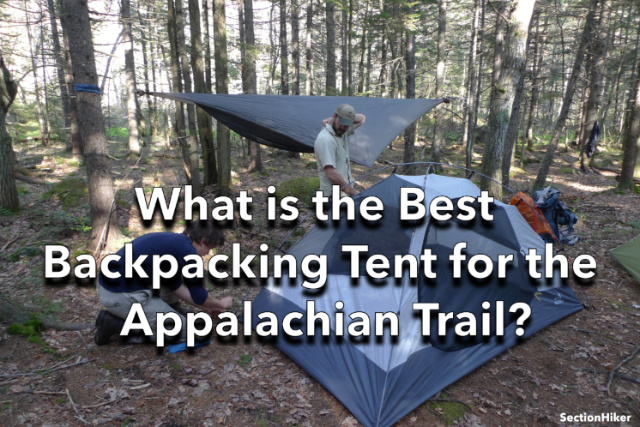
What’s the greatest backpacking tent or tenting shelter for thru-hiking or part mountaineering all or among the Appalachian Path? Operating over 2,000 miles from Georgia to Maine, the Appalachian Path travels throughout closely forested and mountainous terrain, with broadly various temperatures, each cold and hot. Frequent rain, ferocious insect life, and hiker competitors for good tenting areas are all essential elements to contemplate when deciding on a tent or shelter to hike the path.
Given the selection of single-wall and double-wall tents, q hammock, flat tarps, and formed tarps, which one is the perfect to make use of? Are you able to simply sleep and shelters and never carry a tent in any respect? What about early spring or winter mountaineering situations? I’ve skilled all of those approaches whereas part mountaineering the Appalachian Path and the reply is…it relies upon:
- On nighttime temperatures
- On biting bugs
- On the provision of fine campsites
- In your pockets
- In your tolerance for carrying cumbersome gear and extra gear weight
- In your want for private consolation
Let’s check out the totally different choices and think about their benefits and downsides.
Single-Wall Tents
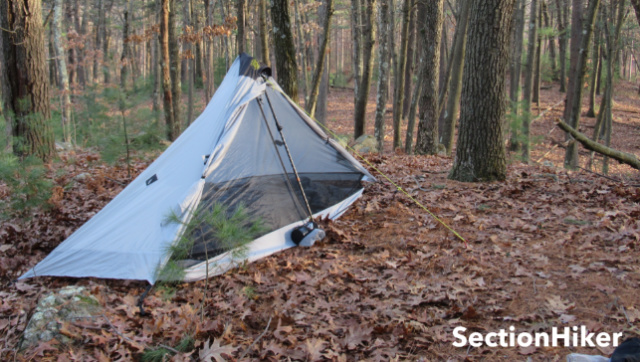
Most single-wall tents have partitions which are half stable and half mesh. This improves airflow by way of the tent and helps to stop inside condensation. Most single-wall tents have a completely built-in bathtub flooring that’s sewn to the partitions of the tent, making it straightforward to maintain the inside dry if you need to arrange within the pouring rain. Many even have an built-in entrance or facet vestibule that can be utilized to cowl gear in dangerous climate. Widespread fashions embrace the Zpacks Duplex, the Gossamer Gear “The One”, Six Moon Designs’ Lunar Solo, and the Tartpent’s Rainbow.
Benefits on the AT
- Straightforward and quick to arrange
- Glorious airflow which helps cut back inside condensation
- Light-weight and compact
- Arrange with trekking poles, which helps eradicate some weight
- Bug-proof and slither proof
Disadvantages on the AT
- Drafty and chilly in cool climate.
- Requires good campsites with degree floor and ample house to arrange
- Troublesome to pitch on picket platforms at designated campsites
Double Wall Tents

Double-wall tents provide glorious climate safety, particularly in cool, windy, and moist climate in the course of the cooler spring and autumn shoulder season months on the Appalachian Path. They’ve an inside tent with a tub flooring, mesh partitions. and a separate rain fly that covers the inside tent and collects any inside condensation which will happen at night time.
There are two kinds of double-walled tents: tents the place you need to arrange the inside tent earlier than you pitch the rain fly; and double-walled tents the place you’ll be able to pitch the rain fly and inside tent on the similar time, or with the rain fly first after which cling the inside tent beneath them: the Durston X-Mid-1 and the Tarptent Notch don’t require a “quick fly” footprint to arrange, whereas the Large Agnes Copper Spur UL2 and the NEMO Hornet Elite OSMO 1 & 2 do.
Benefits on the AT
- Can be utilized in all three-season climate situations, together with colder climate
- Wind-proof with absolutely enclosed partitions
- Bug-proof and slither proof
- Normally, have a vestibule for coated gear storage
- Internal tents have deep bathtub flooring that may stop flooding if water swimming pools beneath
Disadvantages on the AT
- Could be onerous to seek out campsites with enough house or degree floor
- Are typically heavier and bulkier than tarps and tarp tents though weights have been coming down.
Hammock w/ Tarp
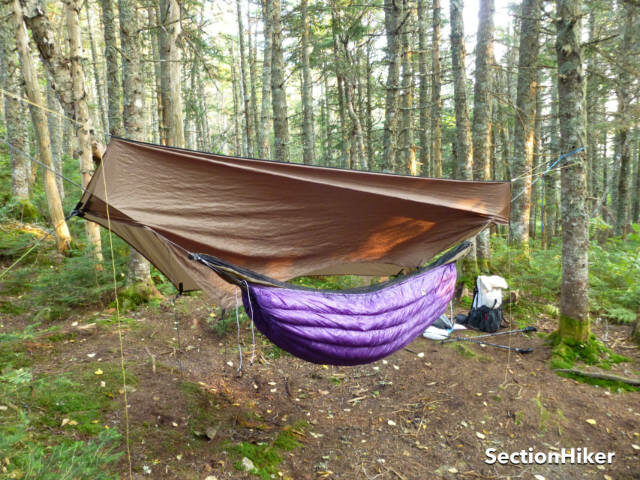
Hammocks are available a variety of shapes, lengths, and weights, starting from tricked-out backpacking hammocks like a Hammock Gear Wanderlust or a no-frills ENO Singlenest. The largest benefit of utilizing a hammock is that you could make camp wherever there are timber to hold your hammock from, which is nearly all over the place on the Appalachian Path (so long as rules allow). That’s an enormous benefit since there are quite a lot of locations on the AT the place it’s onerous to discover a respectable place to camp: the place there’s no degree floor, the place the campsites fill with water within the rain, or the place crowded situations require using stealth website.
Benefits on the AT
- Nice for tenting in forests, particularly when good ground-level campsites are scarce
- Bug proof and slither proof, offered you add a bug web in case your hammock doesn’t include one
- By no means have to fret about rain flooding your shelter flooring
- Gives protection on your gear at night time and a spot to cook dinner out of the rain
- Straightforward to pack and arrange when used with snakeskins
- Nice stealth tenting choice
Disadvantages on the AT
- Requires additional backside insulation and wind safety layers beneath 60-70 levels which might be costly, cumbersome, and heavy in comparison with different choices.
- Not choice when no timber can be found. It occurs, even on the AT.
Flat Tarps

Flat sq. or rectangular tarps have sq., 90-degree corners and are form of old-fashioned now. They’re price mentioning, nevertheless, as a result of they’re cheap, light-weight, and extremely adaptable since they are often arrange in many alternative shapes and orientations. In addition they match very nicely into slim areas between timber and might incorporate panorama options like fallen timber and enormous boulders.
Pitching them is a little bit of an artwork kind and requires quite a lot of creativity, however can be quite a lot of enjoyable. Nonetheless, good campsite choice is essential as a result of flat tarps don’t have flooring and have to be augmented with an inside bug bivy or bivy sacks to offer extra bug and wind safety. Widespread flat tarps embrace the Hyperlite Mountain Gear Flat Tarp and the Hammock Gear Traverse Tarp.
Benefits on the AT
- Very light-weight and compact
- Low price
- Probably the most primary A-frame pitch is straightforward to grasp
- Could be pitched utilizing trekking poles or tied to timber/shrubs
- Doesn’t require a flat floor to pitch
- Could be configured in an infinite variety of methods, together with ones that incorporate panorama options akin to fallen logs or boulders
- Can match into slim areas between timber, unusable by different shelters
Disadvantages on the AT
- Doesn’t present as a lot chilly, damp, or wind safety as a shelter with a flooring that’s absolutely enclosed on all sides
- Requires some type of bug safety akin to a bug web or bug bivy
- Takes significantly extra talent and observe to grasp establishing
- Requires that you simply carry extra stakes and man strains since you by no means know what “form” you’ll pitch prematurely
Mids and Formed Tarps

Mids (quick for pyramid) and formed tarps differ from flat tarps in that they’ll solely be pitched a method, as dictated by their form. They’re primarily floorless single-wall tents with out an inside tent, though most individuals choose to make use of some form of inside shelter with them on the AT for rain and bug safety. These inside shelters are equal to the inside tents present in double-walled tents. Alternatively, you need to use an ultralight bivy bag with a mesh cowl over the face, typically with some form of UL footprint. Nonetheless, whenever you issue within the want for an inside tent, it virtually makes extra sense to purchase an all-in-one single-walled shelter or tarp tent since they’re the cheaper choice.
Formed tarps embrace pyramids, double-apex tarps, A-frames with entrance vestibules, catenary minimize tarps, and so forth. Widespread fashions embrace the Hyperlite Mountain Gear Ultamid 2, the Mountain Lauren Designs Duomid, and the Zpacks Hexamid Pocket Tarp with Doorways.
Benefits for the AT
- Light-weight and simply packable
- Bug and slither proof when used with an inside tent or bivy sack
- Partitions might be raised for higher air flow or pitched flush with the bottom to guard in opposition to rain
- Many arrange with trekking poles, which helps eradicate some weight
Disadvantages on the AT
- Requires good campsites with degree floor and ample house to arrange
- Troublesome to pitch on picket platforms at designated campsites
No Tent or Shelter: Simply Use AT Lean-tos
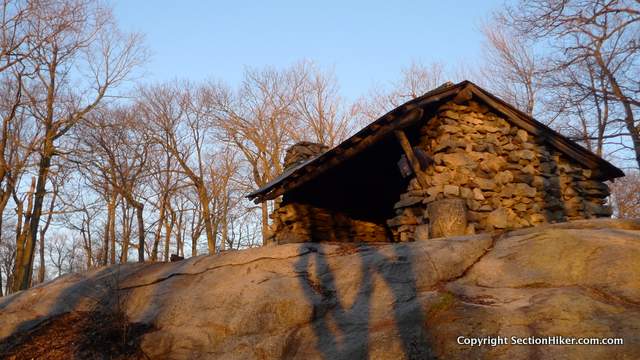
One choice is to hike the Appalachian Path or a piece of it and never take a shelter in any respect, with the intent of simply utilizing the designated lean-tos that are spaced at 10-15 mile intervals. I’d advise in opposition to doing this as a result of having a tent or shelter with you is a vital piece of security gear, when you have an accident and might’t go on, climate situations pin you down, you’ll be able to’t make it to a shelter every night time, a shelter is already full whenever you arrive (first come, first serve) the shelter has resident Copperheads, Rattlers, or a wasp’s nest inside, you don’t wish to share a shelter with the individuals already there, or it’s so disgusting and decrepit that you simply’d by no means wish to sleep in it.
Deliver a light-weight tent or shelter, even for those who solely use it sometimes. You’ll be glad you probably did.
Tents and Shelters for Winter Situations
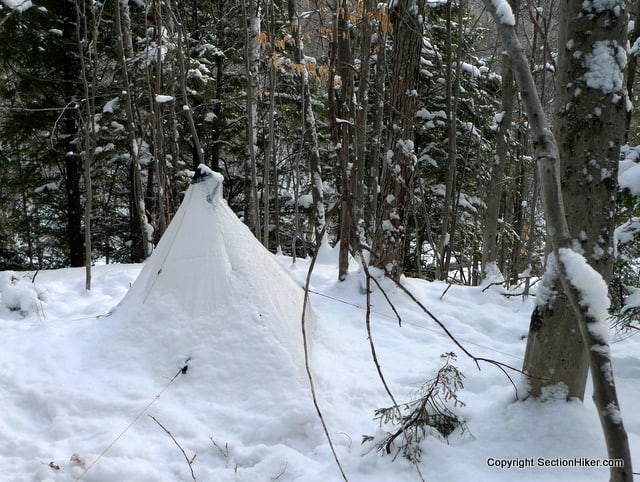
Hikers, particularly thru-hikers, are more and more taking to the Appalachian Path in March to keep away from path crowding although winter situations nonetheless prevail down south. Winter provides a completely totally different dimension to shelter choice on the AT because it’s practically unimaginable to pound tent stakes into the frozen floor in case your shelter requires them. As an alternative, pitching a non-freestanding tent on high of snow requires using deadmen (stakes frozen in place) which takes longer to arrange since they should freeze whilst you wait, whereas 12-14 hour-long nights make shelter consolation and livability extra of a precedence.
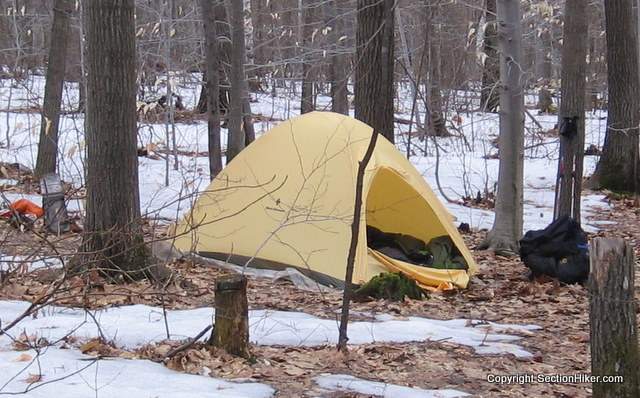
Sadly, not one of the shelter sorts talked about above is right for such situations, until yow will discover single-wall or double-wall tent which is free-standing. Free-standing, light-weight tents are comparatively uncommon however are nice in chilly climate as a result of your physique weight and your gear are sufficient to maintain them from blowing away with out staking within the comparatively protected campsites you discover on the AT. The Large Agnes Copper Spur UL 1 or 2 are good freestanding double-wall tents that steadiness consolation, ease of use, and light-weight.
When you have been fascinated about mountaineering the AT in March (or earlier) and utilizing the lean-tos since they received’t be full, I’d urge you to rethink. Sleeping in a shelter with one open wall in freezing and windy climate the place it’s so chilly that you might want to spend each second of a 14 hour night time in your sleeping bag is the pits. There’s actually no comparability between that and sleeping in a snug, windproof freestanding tent, even when it weighs a bit extra to hold.
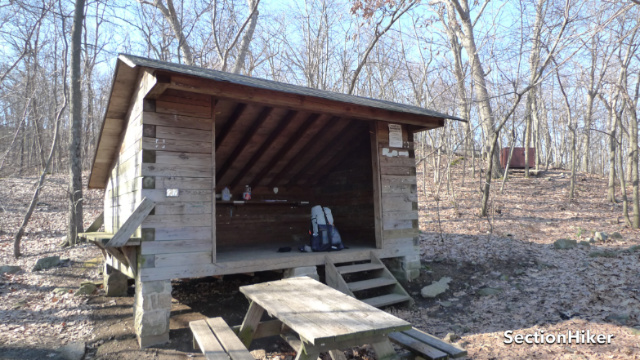
The way to Resolve?
I’ve coated quite a lot of totally different tent and shelter choices above, however how do you resolve which one to deliver? I believe a very powerful elements rely upon the climate you intend to hike in and your private consolation wants.
- If the bottom remains to be frozen and it’s unimaginable to drive stakes into it, I’d advocate utilizing a freestanding tent since you don’t need to stake it out and they are often arrange in rain with out the inside tent turning into moist.
- After nighttime temperatures rise persistently over 40 levels, I consider a hammock is the best choice, so long as you increase it with some backside insulation like a foam pad or underquilt. Completely different quantities of insulation are wanted as temperatures enhance, however the ease of discovering campsites and the flexibility to arrange a dry shelter within the rain are the chief promoting factors of hammock-based shelter programs.
- When you don’t like sleeping in a hammock, you’ll be extra snug switching to a tarp tent which gives higher air flow as the warmth and humidity of spring and summer time enhance.
Whichever tent or shelter you select, don’t overlook that you’ve the choice to hike the Appalachian Path in hotter climate, deferring thru-hikes or part hikes to a later date when you might want to carry much less insulation (clothes and sleeping) and lighter-weight shelters.
SectionHiker is reader-supported. We independently analysis, check, and price the perfect merchandise. We solely generate income if you are going to buy a product by way of our affiliate hyperlinks. Assist us proceed to check and write unsponsored and unbiased gear opinions, newbie FAQs, and free mountaineering guides.
